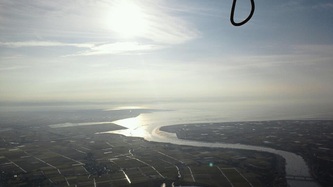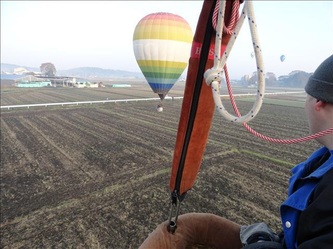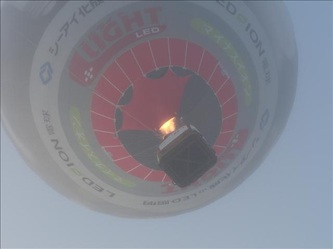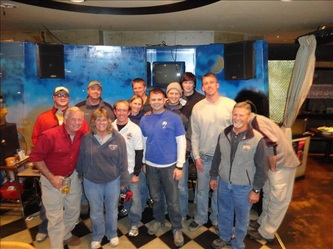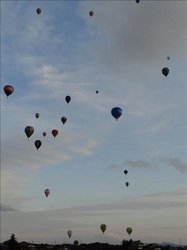Tochigi International Championship
Tochigi, Japan
2011

by NICK DONNER
Ten years ago at the end of October in 2001 I was asked by my teammate for the World Honda Grand Prix if I was able to come to Japan and fly in the final leg of the three leg competition that put international competitors on teams to compete against each other. Because of foot and mouth disease in Europe the second leg of the competition had been moved from Luxembourg to Saga, Japan and my teammate could not take off two weeks from work within just a few weeks. The recent terrorist attacks in September 2001 allowed for very cheap and nearly on a moments notice my mom, brother and I embarked on a weeklong trip half way around the world. I have since returned to Japan on 11 other occasions and competed and crewed now 12 times.
This year traveling to the Tochigi Provence just north of Tokyo in Japan would be slightly different than in past years. Japan had a magnitude 9.1 earthquake March that resulted in a Tsunami and impending nuclear problems just 100 km to the northeast of the competition area we would be in. There were concerns from the very beginning about possible radiation in the area and what we should and shouldn't believe from the government. The US State Department told us that travel to within 40 km was absolutely not recommended and that outside of 80 km we could stay up to a year with no problems.
I personally was slightly skeptical of the information that we were receiving but I knew it was important to the Japanese people that things be returned too normal as possible. The balloon competition correlates with the Japanese holiday ‘Thanks Day’ which is the equivalent for Labor Day here in the USA. Many people come to watch the balloons fly and glow around the area during the five days we are there and this event has given me a lot over the years. In the end my brother, Chase, and I both decided to return to Japan and try to win arguably the most competitive event of the year with the top five from the US National Championship in attendance as well as numerous other past and present national and world champions from other countries.
I started my journey over to Japan on Saturday November 19 using a slightly different route than what I have used in the past by flying on UPS from Chicago to Louisville to retrieve some extra balloon equipment for my brother and then flew on UPS to Honolulu non-stop on an MD-11 in comfortable older business style seats and a bunk with my name on it and two hot meals to eat. From Honolulu the plan was to fly on Delta to Tokyo-Narita but because of a misunderstanding with the gate agents and the Delta jump seat policy I was left behind and had to catch a United flight that worked out just fine.
Chase and all three of our crew members Austin, Jared and Joel left Sunday which meant they would land on Monday afternoon and have to make their way up to Haga-town in the dark three hours. The plan was to meet them around 2030 and then we would separate to our respective home-stays for the week and meet up the next morning and get Chase’s balloon equipment in the van and ready for the practice flight on Tuesday morning.
My very nice home-stay family is the same that I had in 2010 and this time they were again expecting two people to show up but I instead showed up with three people and I was the shortest at 6 feet. I asked if they minded us squeezing in some how and they immediately pulled out sheets and a thin mattress for us to use. In Japan it is traditional to sleep on the floor using mats and blankets to keep warm. They also don’t have central heat in most places and every night we had to turn the heat on before we went to bed so that air in the room wasn’t in the 40s. Under the blankets it was always warm but walking to the bathroom in the hallway sometimes could be a bit chilly.
Luckily Austin and Joel would eat pretty much any food and made my home-stay mom very happy that she could prepare traditional food and it would be eaten. I am not to keen on having sushi but I had salmon on two occasions this year and I was pretty happy about that. She also made me pizza and spaghetti so I didn’t have that hard of a time eating when we usually ate with the family in the evenings.
On Tuesday morning we had our first flight of the week and because our crew was very new to Japan and we decided not to go and fly in the mountains where we would most likely be flying the first morning of the competition on Wednesday but to instead fly in the flatland area in the middle part of the competition map that was much easier for chasing the balloons and allowed us to get our balloons out and then fly and land whenever we wanted versus in the mountain area where our crew might not always be able to see us flying.
The weather was so nice that there was almost no wind for us to work with. Chase and I threw three baggies and Chase pretty much hit everything within a few meters and I was off a little bit but the flight was good for the crew and us. That afternoon we had the master briefing where the event director, Les Purfield reviewed the rules and went through any nuances of the event for anyone that had not been there before or things that might have changed from years earlier.
One of the things I really try to stress when I compete is getting enough sleep. During the winter eight hours of sleep is usually the norm because there really isn’t that much daylight. When we do the home-stay thing though our host family likes to have tea in the evenings and eat pretty late so that can be difficult. The first morning’s briefings are also at 0530 so we have to get up around 0430. In a perfect world I would be in bed by 2030 but that didn’t happen once and on several occasions I was so tired at the dinnertime meal I could hardly function. Tuesday night was the welcome party and no exception for getting to bed way to late.
Mayor Tomoyuki Ōtsuka of Haga Town was happy to discuss how the earthquake had affected the town over the last eight months. One of the most visibly different things for me was seeing all the construction that was going on. Every year we come we usually see new roads being built but this year there were houses and businesses that had construction crews working on them. Mayor Ōtsuka mentioned that one of the biggest concerns at first was the drinking water and fish that people rely on for everyday survival. The fish and water had been cleared in that area early on and samples are continually checked. He also mentioned that while the earthquake was bad for tourism the construction that was happening was a good thing as many roads and buildings needed repair work done anyway and these work projects required workers and that in turn helped keep the local economy stable. The town was also very happy to be hosting the 2011 Tochigi International Balloon Competition. It was a way for local people to have things to look forward to because the Thanks Day celebrations are very big in their part of the country. I was very happy to have had the opportunity to talk to the Mayor during his busy schedule.
On Wednesday morning November 23 the Tochigi International Balloon Championship got underway with absolutely perfect weather conditions. We took off from the Twin Ring Motegi raceway where NASCAR has had an exhibition race in the past and where the Indy Racing League has raced for the last several years. The racetrack had received some damage from the earthquake in the oval portion of the track but the IRL cars used the road course this year.
Our four tasks for the morning were a Pilot Declared Goal (PDG), Judge Declared Goal (JDG), JDG and a Fly-On Task (FON). This flight was pretty straightforward and the flight profile was to the north and then east down the Naka river valley where the competition goes at least once a year. This year Chase and I were on the same radio as current World Champ John Petrehn who had his brother Paul (two-time US Champ) and Paul’s girlfriend Erica Hahn crewing for him so the information that would be flowing between us was going to be pretty solid.
Also at the event were Joe and Rhett Heartsill who had both been to Japan several times before along with Richard Sabin who has been coming for several years. In all there were 11 National Championships and three World Championships amongst just the US pilots (13 National if you add Paul’s) that makes for some pretty good competition that we brought over.
For the first task there were really only a few targets to choose from that would allow for easy flying to the next target that was selected by the director. This first one was the intersection of two roads and our crews were easily able to get there before the balloons and could help tell us what the winds were doing near the surface. John was the first balloon into the target and sliced inside to the left of the target and threw back from a great drop a few meters off the center and I followed right behind also missing left and just outside of his drop.
On the second task we had a gravity marker drop (GMD) at the common JDG target and the winds were pretty squirrely as you approached. Balloons would come into the field and go both left and right. Most of the Americans were able to get pretty close by finding winds a few hundred feet up that went mostly directly to the X. The next task was similar but the winds shifted to the right as we crossed a bridge that was in line for the target. This was the worst target for us that morning.
The final task of the morning required a quick trip up 3000 feet and then an even quicker trip back down to a couple hundred feet to try and find winds to take us to the intersection we had all chosen. I had a pretty bad throw at this target because I let the baggie out too late with the faster winds below and it was carried out to 14m. Everyone else that came through faired well and Chase bested our intersection with a drop under a meter from about 40m away.
Wednesday afternoon was a fairly simple flight from a flight-planning standpoint because we had a common launch area and one of the two tasks was already chosen for us. The PDG task allowed us to pick two intersections and then fly on to the JDG. John darn near aced this task flying right over the center of the intersection. The rest of us were pushed a little to the left as we approached. The JDG was a bit more challenging as the winds changed 3-4 times on approach and balloons came into the field from all different directions. Scores did not fair well for the Americans for the most part on this task.
Thursday morning a one part task was called because of poor visibility in the entire flying area but the low fog lifted/parted just enough for us to fly. The winds were brisk above about 1000 feet and changed dramatically and slowed up the lower you flew. Crispin Williams had a great low approach and had a drop at just over a meter to win this target and with most throws coming at higher altitudes scores upwards of 10+ meters turned out ok.
Thursday evening the flight was cancelled for wind, our only flight that cancelled the entire week. That evening to celebrate Thanksgiving the entire American competitive contingent went to the Rhamu restaurant in Motegi, Japan. The owners prepared chicken breast, Yakatori chicken, mashed potatoes, Mac & cheese, stuffing, warm bread and many other things. It was great to just relax and have a few beers with friends and have the evening off. I have spent more Thanksgivings over the past 11 years with these people than I have with my own family in the states.
Friday morning greeted us with five tasks. It was definitely game on at this point and the weather looked to be great for the remainder of the week. The flights from this morning on were going to be on the west side of the map and generally stay away from the mountains. We had a PDG to start and the cooperative winds allowed for approaches from both the Northwest and the Southwest. It turned out that the easier flight plan was from the northwest and the scores on the first two tasks showed just that. John, Chase and I all flew a tight approach to our intersection and had drops under 7m. With the winds below 500 feet flowing south we proceeded to the FIN with another tight approach and the scores reflected the relative easy approach.
Most everyone was able to get the flying conditions handled and move on to a FON task that we all were able to pick. The problem was the as the morning went on the winds began to shift to the left and made for some of the approaches to be more difficult. John and Chase flew to our intersection pretty easily and with a lot of patience and I was blown a little bit to the left but mediocre scores were not good here.
The last two tasks were in a fairly dangerous area to fly around. The HWZ allowed us to pick one of the two goals to fly to but the winds to the east over 1000 feet were very fast. The southern target was most easily accessible but the winds on the surface were near calm and made for very spread out scores. Yudai Fujita won this target making for the second 1000 point score out of the first four targets that morning and setting the precedent for the rest of the flying. The last task was a FON and made for very difficult selection of targets. We had to pick in the mountains where the rotors coming off of them would twist the balloons and shoot us into the air all but making it impossible to control the balloons. I got to about 290 meters from my intersection but because of a rotor I had to fly the balloon rather than worry about scoring and had my score out near 1 kilometer.
Friday afternoon the winds were strong but flyable. We had just one JDG target to fly to that was changed to put it in line with winds after a supplemental briefing on the launch field. There was not a lot of time to fly to the target because of the distance and time left in the day. The winds shifted a couple of times and the best approach was to fly as close to it as possible and then work the upper winds to get closer. I ran out of time and flew a little bit closer before the end of the scoring period but trees up ahead would have made for an impossible retrieval of the baggie. If you took off early and didn't try to work the early winds for the target you had an ok score.
Saturday morning there were six tasks and eight baggies on our table. This morning was going to be very challenging. The first two tasks and three baggies were to be dropped at the main launch field along the river valley. The JDG and the MNDD (min distance double drop) was a good combination to have at the field but if you were off even just a bit you could have two bad scores instead of just one. Rhett and Joe did great here at the field and I missed the targets to the right a little but did get two scores. John and Chase both missed the MNDD.
The next FON task was very competitive and there were several intersections to choose from with the winds we had to work with and scores under 5m were best. The best intersections were more north because the MXDD (max distance double drop) had scoring areas on the north side. Everyone who went to a southern target was automatically giving up some distance on this target.
With two and a half targets left the winds started to slow down. We had to get up to more than 3000 feet to find some speed toward the JDG and eventually the FON. Any drop less than 100 meters on these last two targets was great. Chase had a drop sub 1 meter from several hundred feet up on the JDG to lead Rhett and John on this task. The MXDD turned out with John and I taking the top two spots.
Saturday afternoon we had two targets like we did most evening with the JDG and PDG. The difference tonight was that from the launch area we were given we would not be able to get to the JDG. We were now tasked with flying to a PDG that allowed us to still get as close to the JDG as possible. It was an unfortunate set of circumstances but we made do better than most. The best drop on the JDG was 3 kilometers and any drop less than 100 meters was good on the PDG. Chase and John had good drops from several thousand feet and Rhett bested the Americans with a 10m drop from down low.
Sunday morning we had great flying conditions again with four tasks. First up was a CRAT (calculated rate of time) task where we try to get as close as possible but only certain areas are open at certain times. The worst part was that a good thirty minutes of flight time went away because we had to wait until the best scoring area opened. I finally felt like I had my flying feet under me and flew well to this target. Joe and I both had 1 meter scores here.
The second task was a JDG that given the amount of time to complete the morning we pretty much could not continue to work toward and had to move on to the third task of the morning. This JDG was in a field that we had made an approach near the day before and I think this helped with some of our scores. Drops were pretty close and you needed to be about 5 meters away for a good result.
The last task of the event was a FON and we had four goals we could pick to fly toward. The biggest concern was that if our baggies were not within 50 meters we would get a no result. Chase bested the entire field with a sub 1-meter drop again and the rest of us at least got scores.
All in all this was a great event again. With having observers this was the best event of the entire year that we could have had to lead up to preparing for the World Championship in Battle Creek, MI next year. The event was probably the most competitive of the year also. Japan poses many flying challenges and logistical nightmares at times but it is obviously good enough to have us continue to return. Congrats to Yudai Fujita for his first international win and great job to Team USA for five spots in the top ten with all five of those pilots representing us at the World Championship in 2012.




